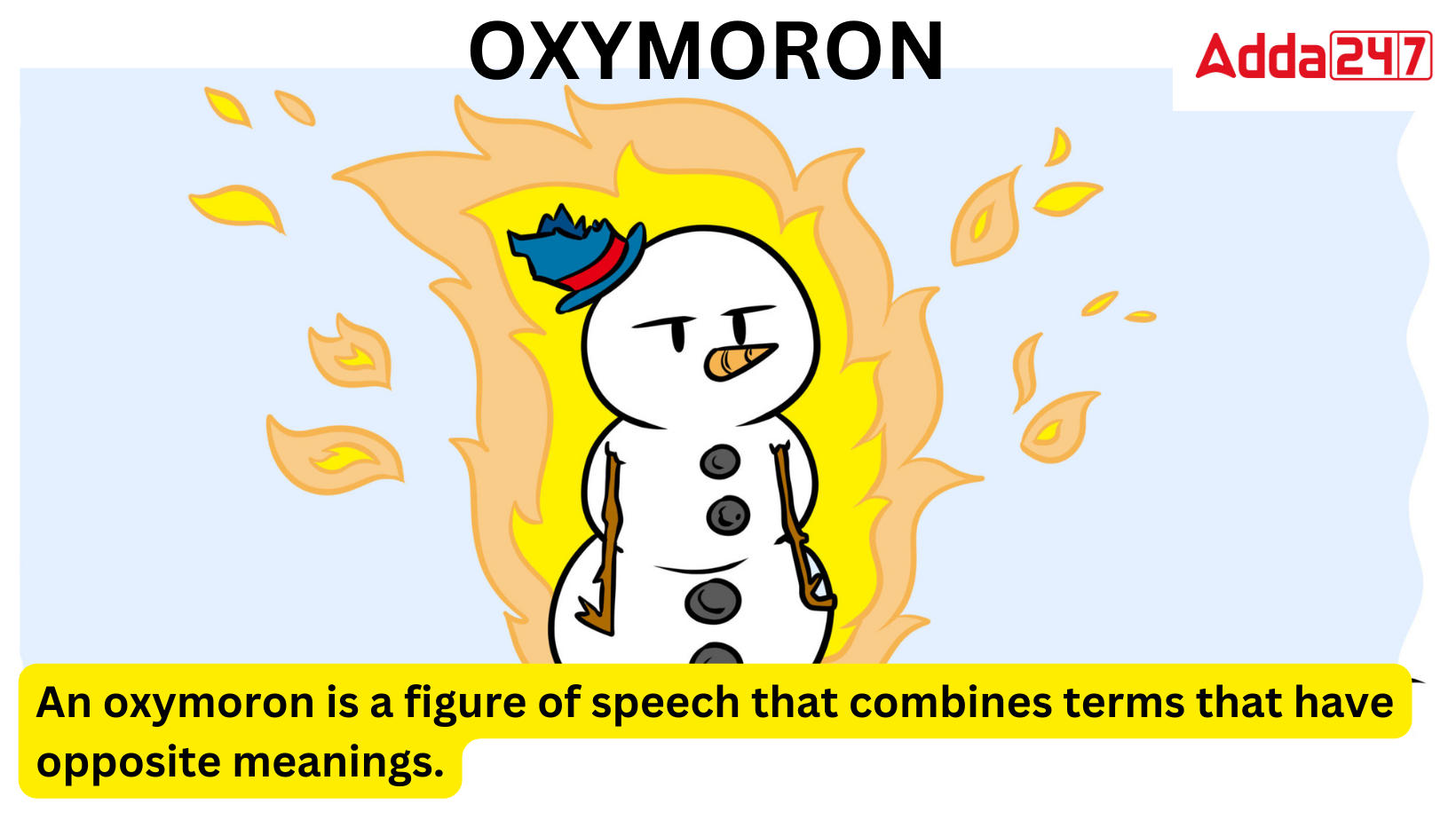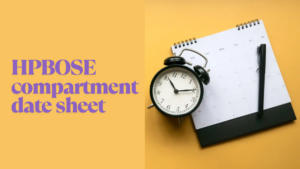An oxymoron is a figure of speech that combines terms that have opposite meanings and is used to express something, such as “ancient news,” “deafening quiet,” or “ordered chaos.” Although oxymorons first appear irrational, they typically make sense when taken in context.
Oxymoron
A literary device that contrasts opposing terms is known as an oxymoron. Oxymorons are frequently employed in poetry as a poetic device to reveal a new interpretation of a word or phrase. As with a paradox, an oxymoron is a “contradiction in terminology,” although as will be clarified below, oxymorons and paradoxes are not the same things.
Oxymoron Meaning
An oxymoron is a rhetorical trick that sequentially employs two opposing or contradictory terms to produce a desired effect. An oxymoron is defined as “a sentence that combines two words that seem to be the opposite of each other” in the Oxford Learner’s Dictionary. An oxymoron is defined as “two words or sentences used together that have, or seem to have, contradictory meanings” by the Cambridge Dictionary.
Oxymoron Definition
The Merriam-Webster Dictionary describes an oxymoron as “a combination of conflicting or discordant terms.” An oxymoron is “a figure of speech in which opposite or conflicting concepts or terms are mixed,” according to the Collins Dictionary.
How to use Oxymorons in a sentence?
The combination of two opposing terms is known as an oxymoron, as was previously mentioned. When creating and employing oxymorons in phrases or sentences, there are a few things to keep in mind. The first thing to bear in mind is that in order for something to be considered an oxymoron, two opposed words must be combined. Additionally, avoid using any two contradictory terms. Not all possible pairings would make sense. You need to carefully consider the impact that a pair of words would have on your audience.
You’ll comprehend better if you look at some examples. There are also several oxymorons that are often used. Additionally, you can look through them to have a clear notion of how they can be created and applied.
Oxymoron Uses in English Sentences
Here are a few examples of oxymorons as used in different forms of literature.
- “His honour rooted in dishonour stood, And faith unfaithful kept him falsely true.” Alfred, Lord Tennyson, Idylls of the King
- We can see multiple instances where William Shakespeare uses oxymorons in his famous play, Romeo and Juliet.
- “Parting is such sweet sorrow.”
- “Why, then, O brawling love! O loving hate!
- O anything, of nothing first create!
- O heavy lightness! Serious vanity!
- Mis-shalien chaos of well-seeming forms!
- Feather of lead, bright smoke, cold fire, sick health!”
- In the poem, Don Juan by Lord Byron, he uses oxymorons to connect the emotions between sadness and happiness.
- “With good, and bad, and worse, alike prolific
Oxymoron Examples Sentences
Here are a few oxymorons that are regularly used and have appeared in English. For your reference, the following table also includes examples of statements containing those oxymorons. Look them up.
| Oxymoron | Sentence Examples |
| Pretty ugly | I feel these patterns are pretty ugly and not up to the mark. |
| True fiction | Sam likes reading works of true fiction. |
| Original copy | They asked us to submit the original copy. |
| Whole piece | Chester demanded that he wanted the whole piece of cake. |
| Virtual reality | Technological advancement in the educational department is completely based on virtual reality. |
| Cruel kindness | Euthanizing their pet dog was considered as an act of cruel kindness. |
| Small crowd | There was only a small crowd in front of the grocery store. |
| Sweet sorrow | There is always such sweet sorrow in witnessing each and every farewell function. |
| Awfully good | The movie seemed to be awfully good. |
| Open secret | Dharini, moving to France, is an open secret. |
| Clearly confused | I could see that he was clearly confused because he did not answer my questions satisfactorily. |
| Organised mess | My work desk is an organised mess. |
| False truth | This is just the false truth. |
| Friendly fight | My sister and I had a friendly fight. |
| Completely unfinished | Santana left the painting completely unfinished. |
| Painfully beautiful | The process of giving birth is painfully beautiful. |
| Awfully pretty | Lalu looked awfully pretty at the party today. |
| Alone together | They seemed to be enjoying each other’s company alone together. |
| Growing smaller | My brother feels that I am growing smaller every time he comes back after a trip. |
| Only choice | Taking up this job offer was my only choice. |
| Working holiday | Tomorrow is a working holiday. |
| Unbiased opinion | The teacher asked the students for an unbiased opinion. |
| Walking dead | After an entire day of continuous practice, the participants looked as if they were walking dead. |
| Foolish wisdom | Everyone was amazed at her foolish wisdom. |
| Seriously funny | The final dance was seriously funny. |
Oxymoron vs Paradox
The distinction between an oxymoron and a paradox is often considered to be very minor. Most of the time, people have trouble distinguishing between the two terms. Although there are many characteristics that set oxymorons and paradoxes apart from one another, there are no hard and fast rules for doing so.
While a paradox is a statement or set of statements, an oxymoron combines two concepts that are mutually exclusive. A paradoxical circumstance results from the sentence “paradox is apparently true.”
Every paradox is a whole phrase. On the other hand, an oxymoron has just two words and is self-contradictory. To put it simply, an oxymoron is a description of a paradoxical action, and a paradoxical action is what is meant by the term paradox.
While an oxymoron is just the juxtaposition of two antithetical terms, such as “cold fire,” a paradox might be thought of as a sentence like “freedom is slavery.”
Examining if a figure of speech has two words is the best technique to determine whether it is an oxymoron. In an oxymoron, the first and second words have entirely distinct meanings. The two terms are in opposition to one another. Examples of oxymorons include jumbo shrimp, military intelligence, frosty hot, and hottie-coldy. According to the dictionary, an oxymoron is a paradox that has been condensed into two words (an adjective and a noun, or an adverb and an adjective), and is used to emphasise differences and add greater effect.
Oxymoron Meaning in Hindi
एक ऑक्सीमोरोन भाषण का एक अलंकार है जो उन शब्दों को जोड़ता है जिनके विपरीत अर्थ होते हैं और कुछ को व्यक्त करने के लिए उपयोग किया जाता है, जैसे “प्राचीन समाचार,” “बहरा शांत,” या “आदेशित अराजकता”। हालांकि ऑक्सीमोरोन पहले तर्कहीन दिखाई देते हैं, लेकिन जब संदर्भ में लिया जाता है तो वे आम तौर पर समझ में आते हैं।
एक साहित्यिक उपकरण जो विपरीत शब्दों का विरोध करता है, उसे ऑक्सीमोरोन के रूप में जाना जाता है। एक शब्द या वाक्यांश की एक नई व्याख्या प्रकट करने के लिए ऑक्सीमोरोन अक्सर कविता में एक काव्य उपकरण के रूप में कार्यरत होते हैं। एक विरोधाभास के साथ, एक ऑक्सीमोरोन एक “शब्दावली में विरोधाभास” है, हालांकि जैसा कि नीचे स्पष्ट किया जाएगा, ऑक्सीमोरन और विरोधाभास एक ही चीज नहीं हैं।
Oxymoron Definition in Hindi
एक ऑक्सीमोरोन एक आलंकारिक चाल है जो एक वांछित प्रभाव उत्पन्न करने के लिए क्रमिक रूप से दो विरोधी या विरोधाभासी शब्दों को नियोजित करता है। ऑक्सफोर्ड लर्नर्स डिक्शनरी में एक ऑक्सीमोरोन को “एक वाक्य जो दो शब्दों को जोड़ता है जो एक दूसरे के विपरीत प्रतीत होता है” के रूप में परिभाषित किया गया है। कैंब्रिज डिक्शनरी द्वारा एक ऑक्सीमोरोन को “दो शब्दों या वाक्यों का एक साथ उपयोग किया जाता है, या विरोधाभासी अर्थ लगता है” के रूप में परिभाषित किया गया है।
मेरियम-वेबस्टर डिक्शनरी एक ऑक्सीमोरोन का वर्णन “परस्पर विरोधी या असंगत शब्दों के संयोजन” के रूप में करती है। कोलिन्स डिक्शनरी के अनुसार एक ऑक्सीमोरोन “भाषण का एक अलंकार है जिसमें विपरीत या परस्पर विरोधी अवधारणाएं या शब्द मिश्रित होते हैं”।
दो विरोधी शब्दों के संयोजन को ऑक्सीमोरोन के रूप में जाना जाता है, जैसा कि पहले उल्लेख किया गया था। वाक्यांशों या वाक्यों में ऑक्सीमोरन्स बनाते और नियोजित करते समय, कुछ बातों को ध्यान में रखना चाहिए। ध्यान में रखने वाली पहली बात यह है कि किसी चीज को ऑक्सीमोरोन मानने के लिए दो विपरीत शब्दों को जोड़ना होगा। साथ ही, किन्हीं भी दो परस्पर विरोधी शब्दों के प्रयोग से बचें। सभी संभव जोड़ियों का कोई मतलब नहीं होगा। आपको सावधानीपूर्वक विचार करना होगा कि शब्दों की एक जोड़ी का आपके दर्शकों पर क्या प्रभाव पड़ेगा।
यदि आप कुछ उदाहरण देखेंगे तो आप बेहतर समझ पाएंगे। कई ऑक्सीमोरोन भी हैं जिनका अक्सर उपयोग किया जाता है। इसके अतिरिक्त, आप उन्हें देखकर स्पष्ट समझ सकते हैं कि उन्हें कैसे बनाया और लागू किया जा सकता है।
Oxymoron Examples in Hindi
साहित्य के विभिन्न रूपों में प्रयुक्त ऑक्सीमोरोन के कुछ उदाहरण यहां दिए गए हैं।
“उसका सम्मान अपमान में निहित था, और विश्वासहीन विश्वास ने उसे झूठा सच रखा।” अल्फ्रेड, लॉर्ड टेनीसन, आइडिल्स ऑफ द किंग
हम ऐसे कई उदाहरण देख सकते हैं जहां विलियम शेक्सपियर अपने प्रसिद्ध नाटक, रोमियो और जूलियट में ऑक्सीमोरन्स का उपयोग करते हैं।
“बिछुड़ना मधुर दुख है।”
“फिर क्यों, हे झगड़ालू प्रेम! ओ प्यार नफरत!
हे कुछ भी, पहले कुछ भी नहीं बनाओ!
हे भारी लपट! गंभीर घमंड!
सुहावने रूपों की मिस-शालियाँ अराजकता!
सीसे का पंख, तेज धुआँ, ठंडी आग, बीमार स्वास्थ्य!”
लॉर्ड बायरन की कविता, डॉन जुआन में, वह उदासी और खुशी के बीच भावनाओं को जोड़ने के लिए ऑक्सीमोरन्स का उपयोग करता है।
“अच्छे, और बुरे, और बदतर, समान रूप से विपुल के साथ
Oxymoron Figure of Speech QNAs
Que. What is an oxymoron example?
Ans. An oxymoron is a figure of speech that combines terms that have opposite meanings and is used to express something, such as “ancient news.”
Que. What is the simple meaning of an oxymoron?
Ans. The combination of two opposing terms is known as an oxymoron.
Que. How is oxymoron used?
Ans. When creating and employing oxymorons in phrases or sentences, there are a few things to keep in mind. The first thing to bear in mind is that in order for something to be considered an oxymoron, two opposed words must be combined. Additionally, avoid using any two contradictory terms.
Que. Does oxymoron mean the opposite?
Ans. Oxymoron is a figure of speech in which two words or phrases with opposing meaning are used intentionally for effect whereas Tautology or Pleonasm means the use of same thing twice over in different words generally considered to be a fault of style.
Que. What is the most famous oxymoron?
Ans. The most famous oxymorons are:
- small crowd
- bitter good
- awfully sweet
- exact estimate









 HPBOSE Compartment Date Sheet 2025 Out, ...
HPBOSE Compartment Date Sheet 2025 Out, ...
 RUHS Counselling 2025 Round 1 Seat Allot...
RUHS Counselling 2025 Round 1 Seat Allot...
 Bihar Board Dummy Registration Card 2026...
Bihar Board Dummy Registration Card 2026...










